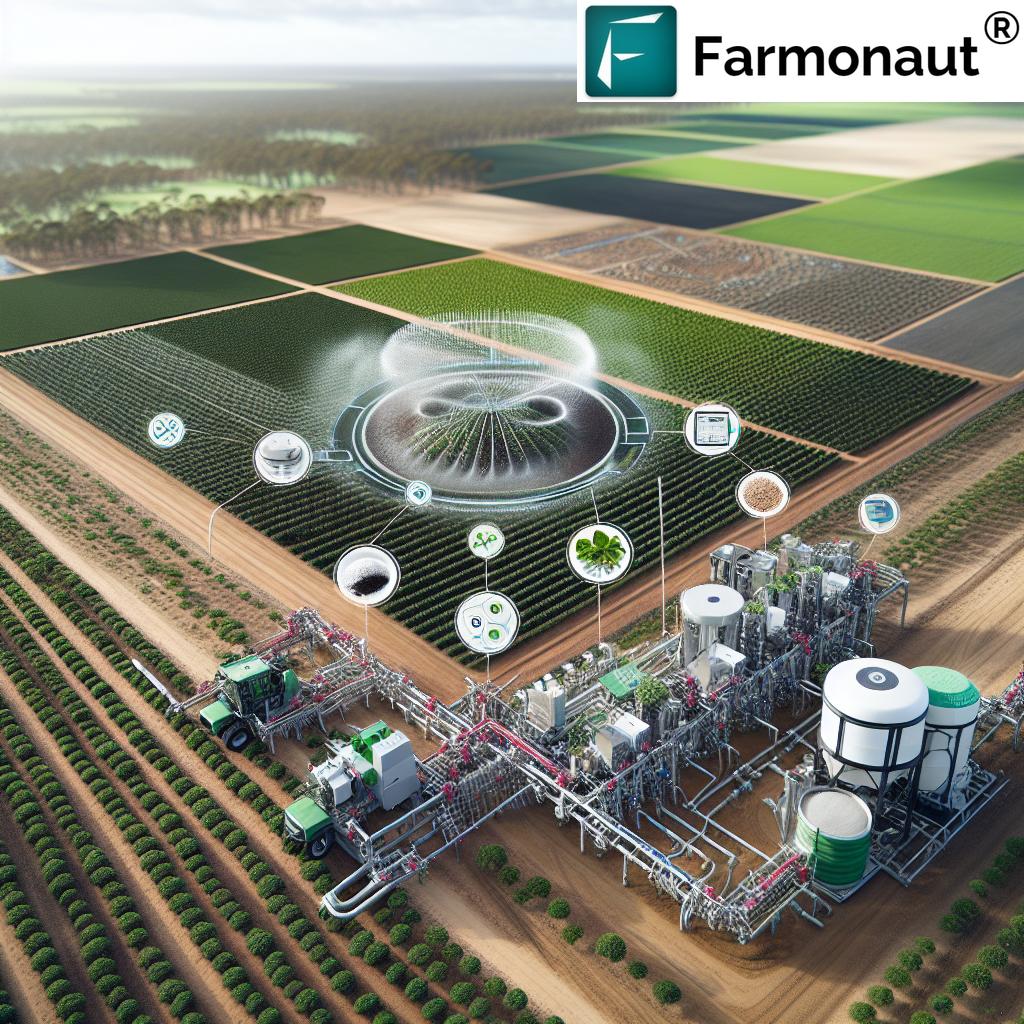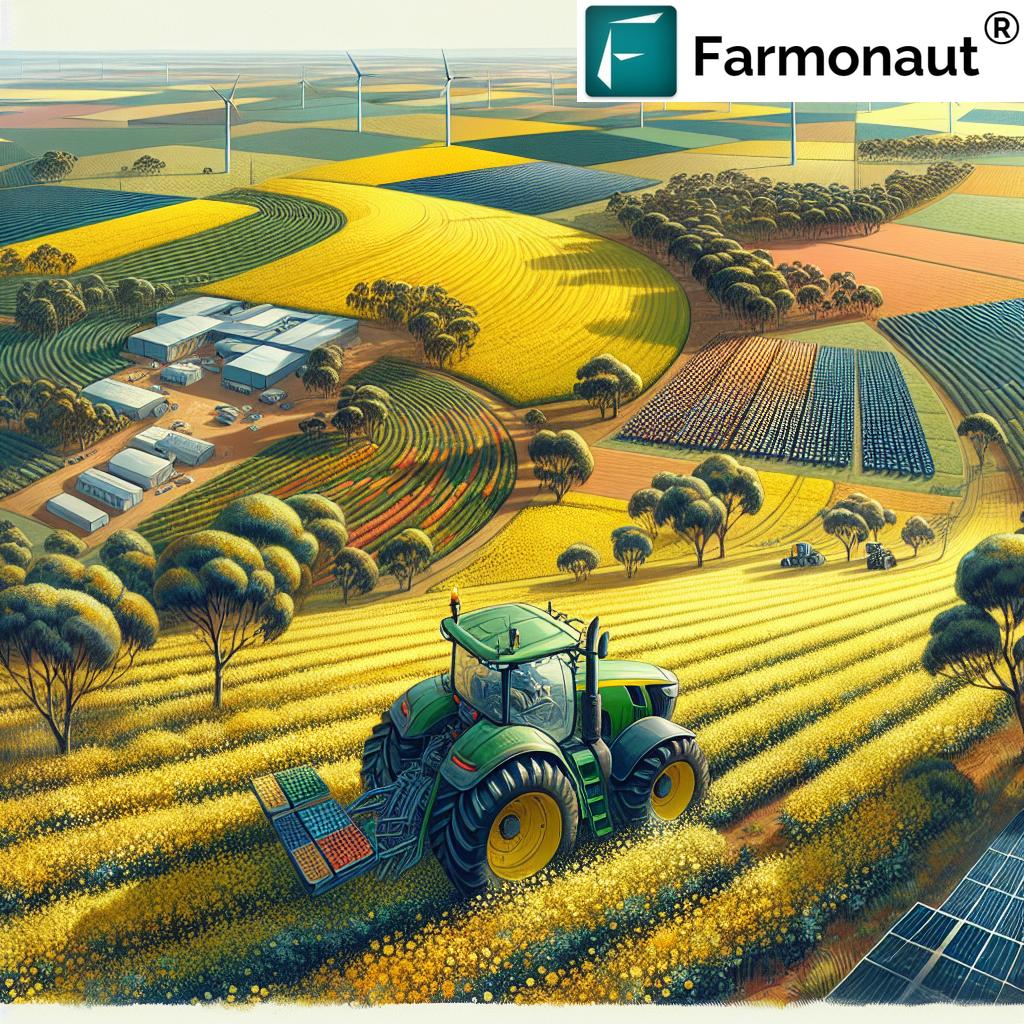Revolutionizing Cotton Farming: How Precision Nitrogen Management Boosts Yields and Sustainability in Australian Agriculture
“Australian cotton trials using nitrification inhibitors and polymer-coated urea have shown up to 20% increase in nitrogen use efficiency.”
Welcome to the future of cotton farming in Australia! At Farmonaut, we’re excited to explore how cutting-edge agritech solutions are transforming the landscape of cotton production, particularly in the realm of nitrogen use efficiency. In this comprehensive blog post, we’ll delve into innovative approaches to sustainable cotton farming, with a focus on precision nitrogen application and advanced irrigation systems.
As we navigate through the intricacies of modern cotton cultivation, we’ll uncover groundbreaking trials utilizing nitrification inhibitors and polymer-coated urea, technologies that are revolutionizing crop yields while simultaneously reducing environmental impact. We’ll also explore the latest research on optimizing nitrogen management in agriculture, including advanced soil and plant analysis techniques specifically tailored for cotton fields.

Join us as we dive into the world of digital agriculture, where smart technologies are reshaping traditional farming practices. From enhancing cotton lint yields to implementing water-efficient irrigation methods, this article aims to provide valuable insights for growers seeking to maximize both productivity and sustainability in their operations.
At Farmonaut, our mission is to empower farmers with digital tools and services that enable data-driven decision-making, ultimately leading to more efficient and profitable cotton cultivation. Let’s embark on this comprehensive journey into the future of sustainable cotton production!
The Evolution of Nitrogen Management in Cotton Farming
Nitrogen management has long been a critical aspect of cotton farming, playing a pivotal role in determining crop yields and quality. Historically, farmers relied on traditional methods of nitrogen application, often resulting in inefficiencies and environmental concerns. However, the landscape of cotton cultivation is rapidly changing, thanks to advancements in agricultural technology and research.
- Traditional Approaches: Broadcast application of nitrogen fertilizers
- Modern Techniques: Precision nitrogen application, use of nitrification inhibitors, and polymer-coated urea
- Digital Revolution: Satellite-based crop monitoring and AI-driven nutrient management
The shift towards precision agriculture has been particularly transformative in the cotton industry. By leveraging technologies such as satellite imagery, soil sensors, and data analytics, farmers can now tailor their nitrogen application to the specific needs of their crops, resulting in improved nitrogen use efficiency and reduced environmental impact.
Precision Nitrogen Application: A Game-Changer for Cotton Growers
Precision nitrogen application represents a significant leap forward in cotton farming practices. This approach allows for the targeted delivery of nitrogen fertilizers, ensuring that crops receive the right amount of nutrients at the right time and in the right place.
Key benefits of precision nitrogen application include:
- Optimized crop nutrition
- Reduced fertilizer waste
- Minimized environmental impact
- Improved cotton lint yields
- Enhanced overall farm profitability
At Farmonaut, we’re at the forefront of this revolution, offering advanced satellite-based farm management solutions that enable precise nitrogen management. Our platform provides real-time insights into crop health, soil conditions, and nitrogen requirements, empowering farmers to make informed decisions about fertilizer application.
Nitrification Inhibitors: Enhancing Nitrogen Efficiency in Cotton Fields
Nitrification inhibitors have emerged as a powerful tool in the quest for improved nitrogen use efficiency in cotton production. These compounds work by slowing down the conversion of ammonium to nitrate in the soil, effectively reducing nitrogen losses through leaching and denitrification.
Research has shown that the use of nitrification inhibitors in cotton farming can lead to:
- Increased nitrogen retention in the root zone
- Improved crop uptake of nitrogen
- Reduced nitrate leaching into groundwater
- Lower greenhouse gas emissions
- Potential yield increases of up to 10-15%
Australian cotton trials incorporating nitrification inhibitors have demonstrated promising results, with some studies reporting significant improvements in nitrogen use efficiency and crop yields.
Polymer-Coated Urea: A Slow-Release Solution for Sustainable Cotton Farming
Polymer-coated urea represents another innovative approach to nitrogen management in cotton cultivation. This technology involves encasing urea fertilizer granules in a polymer coating, which controls the release of nitrogen over time.
The advantages of using polymer-coated urea in cotton farming include:
- Gradual and consistent release of nitrogen throughout the growing season
- Reduced risk of nitrogen losses through volatilization and leaching
- Improved synchronization between nitrogen supply and crop demand
- Potential for reduced fertilizer application frequency
- Enhanced environmental sustainability
Recent trials in Australian cotton fields have shown that polymer-coated urea can significantly improve nitrogen use efficiency, with some studies reporting increases of up to 20% compared to conventional urea applications.
“Precision nitrogen management in cotton farming can reduce fertilizer application by up to 30% while maintaining or improving yields.”
Advanced Irrigation Systems: Optimizing Water and Nitrogen Use
Efficient irrigation is crucial for maximizing nitrogen use efficiency in cotton production. Modern irrigation systems not only conserve water but also play a vital role in optimizing nutrient uptake by the crop.
Key advancements in cotton irrigation systems include:
- Drip irrigation for precise water and nutrient delivery
- Subsurface drip irrigation (SDI) for reduced evaporation losses
- Smart irrigation controllers that adjust water application based on real-time soil moisture data
- Fertigation systems that combine irrigation with fertilizer application
These advanced irrigation technologies, when integrated with precision nitrogen management strategies, can significantly enhance both water and nitrogen use efficiency in cotton farming.

Soil and Plant Analysis: The Foundation of Effective Nitrogen Management
Accurate soil and plant analysis forms the cornerstone of effective nitrogen management in cotton farming. These analyses provide critical insights into the nutrient status of the soil and the crop’s nutritional needs, enabling farmers to make informed decisions about fertilizer application.
Key components of soil and plant analysis for cotton include:
- Soil nitrate testing
- Petiole nitrate analysis
- Leaf tissue analysis
- Soil organic matter assessment
- Soil pH and electrical conductivity measurements
At Farmonaut, we integrate these analytical insights with our satellite-based crop monitoring to provide a comprehensive view of field conditions and nutrient requirements. This holistic approach allows for more precise and timely nitrogen management decisions.
Digital Agriculture: Transforming Cotton Farming with Smart Technologies
The digital revolution in agriculture is reshaping cotton farming practices, offering unprecedented opportunities for optimization and sustainability. Smart technologies are enabling farmers to make data-driven decisions, leading to improved resource management and increased profitability.
Key digital agriculture technologies impacting cotton farming include:
- Satellite-based crop monitoring
- AI-driven advisory systems
- IoT sensors for real-time field data collection
- Precision application equipment guided by GPS
- Farm management software for data analysis and decision support
Farmonaut’s digital platform integrates these technologies to provide cotton growers with comprehensive farm management solutions. Our satellite-based crop health monitoring, combined with AI-powered insights, enables precise nitrogen management and overall farm optimization.
Explore our digital solutions:
Improving Cotton Lint Yields through Precision Nitrogen Management
Optimizing nitrogen management is crucial for improving cotton lint yields. Precision application techniques, combined with advanced technologies, can lead to significant increases in both yield quantity and quality.
Strategies for improving cotton lint yields through precision nitrogen management include:
- Tailoring nitrogen application rates to specific growth stages
- Using split applications to match nitrogen supply with crop demand
- Implementing variable-rate technology for site-specific management
- Monitoring crop nitrogen status through remote sensing and tissue analysis
- Adjusting nitrogen strategies based on real-time weather data and crop models
By leveraging Farmonaut’s digital tools, cotton growers can implement these strategies more effectively, leading to optimized lint yields and improved fiber quality.
Sustainable Cotton Production: Balancing Productivity and Environmental Stewardship
Sustainable cotton production is becoming increasingly important as the industry faces mounting pressure to reduce its environmental footprint. Precision nitrogen management plays a crucial role in achieving this balance between productivity and sustainability.
Key aspects of sustainable cotton production include:
- Minimizing nitrogen losses to the environment
- Reducing greenhouse gas emissions associated with fertilizer use
- Improving water quality by preventing nitrate leaching
- Enhancing soil health through optimized nutrient management
- Implementing integrated pest management strategies
Farmonaut’s digital agriculture solutions support sustainable cotton production by enabling more efficient resource use and providing insights for environmentally conscious decision-making.
The Role of Agritech Solutions in Optimizing Cotton Production
Agritech solutions are playing an increasingly vital role in optimizing cotton production, particularly in the realm of nitrogen management. These technologies offer unprecedented capabilities for monitoring, analysis, and precision application.
Key agritech solutions revolutionizing cotton farming include:
- Satellite-based vegetation indices for crop health assessment
- Machine learning algorithms for yield prediction and fertilizer recommendations
- Blockchain-based traceability systems for supply chain transparency
- Drone technology for high-resolution field mapping and targeted treatments
- Mobile apps for real-time farm management and decision support
Farmonaut’s comprehensive agritech platform integrates these cutting-edge technologies to provide cotton growers with powerful tools for optimizing their operations. Our solutions enable data-driven decision-making, leading to improved nitrogen use efficiency and overall farm productivity.
Discover our API solutions for developers:
Comparison of Nitrogen Management Techniques in Cotton Farming
| Nitrogen Management Technique | Estimated Yield Increase (%) | Nitrogen Use Efficiency (%) | Environmental Impact | Water Use Efficiency (%) | Implementation Cost |
|---|---|---|---|---|---|
| Traditional broadcast application | Baseline | 30-50 | High | 60-70 | Low |
| Precision nitrogen application | 10-15 | 60-70 | Medium | 75-85 | Medium |
| Nitrification inhibitors | 5-10 | 55-65 | Low | 70-80 | Medium |
| Polymer-coated urea | 8-12 | 65-75 | Low | 75-85 | High |
| Farmonaut’s digital nitrogen management solution | 15-20 | 70-80 | Low | 80-90 | Medium |
This table provides a comprehensive comparison of various nitrogen management techniques in cotton farming, highlighting the advantages of modern approaches, particularly Farmonaut’s digital solution. It’s important to note that actual results may vary depending on specific field conditions, management practices, and environmental factors.
Future Trends in Nitrogen Management for Cotton Production
As we look to the future of cotton farming, several emerging trends in nitrogen management are poised to further revolutionize the industry:
- Nanotechnology-enhanced fertilizers: Developing fertilizers with improved efficiency and reduced environmental impact
- Gene editing for nitrogen use efficiency: Creating cotton varieties with enhanced nitrogen uptake and utilization capabilities
- AI-powered predictive modeling: Utilizing machine learning algorithms to forecast nitrogen requirements based on complex environmental and crop data
- Bioengineered soil microbes: Harnessing beneficial microorganisms to enhance nitrogen fixation and availability in the soil
- Closed-loop nutrient recycling systems: Implementing technologies to recover and reuse nitrogen from agricultural runoff and waste
At Farmonaut, we’re committed to staying at the forefront of these technological advancements, continually evolving our platform to provide cotton growers with the most cutting-edge tools for nitrogen management and overall farm optimization.
Conclusion: Embracing the Future of Sustainable Cotton Farming
As we’ve explored throughout this comprehensive blog post, the landscape of cotton farming is undergoing a remarkable transformation, driven by advancements in precision nitrogen management and digital agriculture technologies. From nitrification inhibitors and polymer-coated urea to satellite-based crop monitoring and AI-driven advisory systems, the tools available to modern cotton growers are more sophisticated and effective than ever before.
By embracing these innovative approaches, cotton farmers can significantly improve their nitrogen use efficiency, boost yields, and reduce their environmental impact. The integration of precision agriculture techniques with advanced irrigation systems and data-driven decision-making processes is paving the way for a more sustainable and profitable future for the cotton industry.
At Farmonaut, we’re proud to be at the forefront of this agricultural revolution, providing cotton growers with the digital tools and insights they need to thrive in an increasingly complex and challenging environment. Our commitment to innovation and sustainability drives us to continually evolve our platform, ensuring that we deliver the most effective solutions for modern cotton farming.
As we look to the future, the potential for further advancements in nitrogen management and sustainable cotton production is truly exciting. By staying informed about the latest research and technologies, and by leveraging platforms like Farmonaut, cotton growers can position themselves for long-term success in an ever-changing agricultural landscape.
We invite you to explore our range of digital agriculture solutions and join us in revolutionizing cotton farming for a more sustainable and prosperous future.
FAQ Section
Q: What is precision nitrogen management in cotton farming?
A: Precision nitrogen management in cotton farming involves the targeted application of nitrogen fertilizers based on specific crop needs, soil conditions, and environmental factors. It utilizes technologies such as satellite imagery, soil sensors, and data analytics to optimize nitrogen use efficiency and improve crop yields while minimizing environmental impact.
Q: How do nitrification inhibitors improve nitrogen efficiency in cotton production?
A: Nitrification inhibitors slow down the conversion of ammonium to nitrate in the soil, reducing nitrogen losses through leaching and denitrification. This results in increased nitrogen retention in the root zone, improved crop uptake, and potentially higher yields with less environmental impact.
Q: What are the benefits of using polymer-coated urea in cotton farming?
A: Polymer-coated urea provides a slow-release source of nitrogen, offering benefits such as gradual and consistent nutrient supply throughout the growing season, reduced risk of nitrogen losses, improved synchronization between nitrogen supply and crop demand, and enhanced environmental sustainability.
Q: How does Farmonaut’s digital platform contribute to improved nitrogen management in cotton?
A: Farmonaut’s digital platform uses satellite-based crop monitoring, AI-driven insights, and real-time data analytics to provide farmers with precise information about crop health, soil conditions, and nitrogen requirements. This enables more accurate and timely nitrogen management decisions, leading to improved efficiency and sustainability in cotton production.
Q: What role do advanced irrigation systems play in optimizing nitrogen use in cotton farming?
A: Advanced irrigation systems, such as drip irrigation and smart controllers, play a crucial role in optimizing both water and nitrogen use efficiency. These systems allow for precise delivery of water and nutrients, reducing losses and ensuring that cotton plants receive the right amount of resources at the right time, thereby maximizing yields and minimizing environmental impact.
















